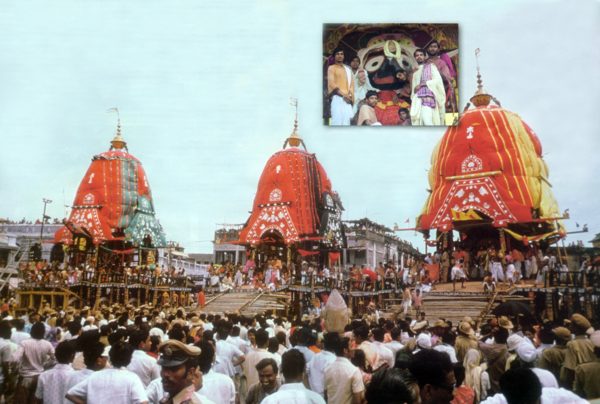
Srila Prabhupada and his followers have exported one of
India's greatest religious festivals to cities around the world.
The Rathayatra ("chariot festival") of Lord Jagannatha has been held in Puri, Orissa, and in other places in India for thousands of years. In the West the first Rathayatra of Lord Jagannatha (a form of Krsna) took place thirty-six years ago, in 1967, in San Francisco. Srila Prabhupada then introduced Jagannatha worship and the Rathayatra in many cities around the world.
In February 1970, Srila Prabhupada wrote to Hanuman Prasad Poddar (the founder of Gita Press, with whom Prabhupada had a friendly relationship): "The Deities worshiped in [ISKCON] temples are Jagannatha Swami with Balarama and Subhadra and Radha-Krishna. When we first start a temple we start with Jagannatha Swami. My Guru Maharaja recommended temples of Jagannatha in these countries, so I was inspired to establish first of all Jagannatha Swami because He is kind even to the mlecchas [persons outside Vedic culture]. Then, when there is opportunity I establish Radha-Krishna murti." In 1973 Srila Prabhupada wrote: "I want to see my disciples all over the world introduce two items, opening Radha-Krishna temples and Rathayatra festivals." Therefore it is certainly not by chance that Lord Jagannatha's worship and the Rathayatra have been introduced in the Western world. It may be safely said that in all countries where ISKCON is well established, Lord Jagannatha is worshiped and the Rathayatra is held.
Jagannatha Worship in the West Begins
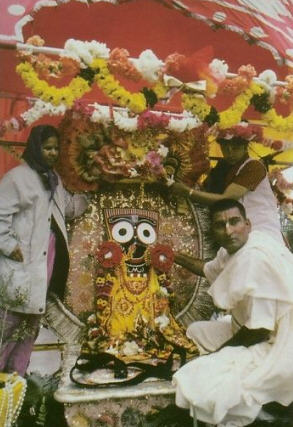
Srila Prabhupada spent the first part of his life in Calcutta, and there he met his spiritual master, Srila Bhaktisiddhanta Sarasvati Thakura, who requested him to spread the message of Lord Caitanya throughout the English-speaking world. In September 1965 Srila Prabhupada arrived in America, and in July 1966, after almost a year of great struggle, he established the International Society for Krishna Consciousness (ISKCON). Soon after the first center was opened in New York City, Srila Prabhupada brought the message of Krsna consciousness to San Francisco. There, in early 1967, Lord Jagannatha made His merciful appearance.
One day Malati Devi Dasi, a new disciple of Srila Prabhupada, got a small wooden figure from a shop and showed it to Srila Prabhupada, who at once offered obeisances with folded hands.
Prabhupada happily told Malati, "You have brought Jagannatha, the Lord of the universe. He is Krsna Himself. Thank you very much."
Prabhupada explained to Malati and other devotees that Krsna in the form of Jagannatha is worshiped all over India, but especially in Puri, in the state of Orissa. Countless thousands of pilgrims come there to see and worship Lord Jagannatha along with His brother, Balarama, and His sister, Subhadra.
Then Malati remembered that she had seen two similar figures in the same shop. She immediately went to get them, and indeed, these were the figures of Baladeva and Subhadra. Srila Prabhupada then asked Syamasundara Dasa, Malatis husband, to carve three-foot-tall deities of Jagannatha, Balarama, and Subhadra. Srila Prabhupada installed them in the temple, and San Francisco came to be known among his followers as New Jagannatha Puri.
Prabhupada taught the devotees to chant jagannathah svami nayana-patha-gami bhavatu me: "O Lord of the universe, kindly be visible to Me"and to perform a very simple worship of Lord Jagannatha. Every day the devotees offered Their Lordships new garlands, arati, and so on, and whoever came to the temple brought some gift for Jagannatha, such as fruits, sweets, flowers, and even popcorn.
For the devotees of Lord Jagannatha in India it might not be so easy to imagine what it meant to introduce the worship of Jagannatha in a place where no one had any knowledge of the Vedic culture. Especially in San Francisco at that time, many young people were hippies. But Srila Prabhupada saw them all as spirit souls, parts of Krsna, and patiently and lovingly he awakened in those souls their natural and spontaneous inclination to worship Jagannatha with love and devotion. Then, step by step, he introduced a more strict and detailed procedure of worship. These were not only the first Jagannatha deities worshiped in a temple in the West, but also the first deities in ISKCON.
The First Western Rathayatra
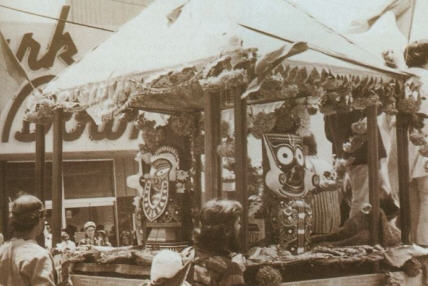
As a sannyasi preacher, Srila Prabhupada did not stay long in one place, and there were so many places all over the world where Krsna consciousness had yet to be introduced. But when Prabhupada saw that the devotees were upset with his leaving San Francisco (they were crying in the airport), he told them, "If you arrange a Rathayatra for Lord Jagannatha this year, then I shall definitely come to see it."
None of his disciples knew how to build a ratha (processional chariot), so Srila Prabhupada advised them to rent a truck, make a ratha-like dome, and decorate it as nicely as possible. They should put the Deities on this "chariot" and organize a procession, which would move slowly through an important street in San Francisco.
The devotees followed his instructions with great sincerity and enthusiasm, and by the grace of the Lord, the first Rathayatra in the Western world was a grand success (July 1967). Many people joined the procession, and the devotees danced and chanted, played the harmonium, drums, and cymbals, passed out apples, oranges, bananas, and chapatis, and threw flowers all around. Everyone was happy, and Srila Prabhupada knew that his spiritual master and Lord Jagannatha were also pleased.
Shortly after that, Rathayatra was introduced in London. Whenever Srila Prabhupada and his disciples would bring Krsna consciousness to a new place, they would introduce the worship of Lord Jagannatha there. As early as 1970, the first Rathayatra was held in Tokyo, Japan. Srila Prabhupada himself took part in ISKCON Rathayatras in different cities several times in San Francisco, and in London, Chicago, Philadelphia, and New York.
Early Inspiration
Prabhupada recalled that throughout his childhood he would think how one day, when he grew up and got some money, he would buy a ticket to Puri and go to see Lord Jagannatha. Later in his life Srila Prabhupada went to Puri, but even at the age of six he conducted his own Rathayatra in Calcutta. Known then as Abhay, he asked his father to buy him a small chariot and help decorate it. Then, under Abhay's leadership, the children of the neighborhood performed the Rathayatra, with their amused parents also taking part. Srila Prabhupada later said that while introducing deity worship and spiritual festivals all over the world, he was doing the same things he had learned and done as a child, with the help of his good parents.
In 1974 Srila Prabhupada wrote to one of his disciples: "This Rathayatra festival is very dear to me from my childhood days, so I very much appreciate your holding this festival in Chicago."
In many other letters, as well as in books, lectures, and conversations, Prabhupada would instruct and inspire his disciples in their loving service to Lord Jagannatha: "So far additions for this year's Rathayatra, you may make three rathas, one for each of the deities. The rest of the details are already there; simply you may supply more money for festoons, decorations, flowers, bells, flags, etc. The spiritual sky is far away, but you just try to do it following Jagannatha Puri Rathayatra."
In a lecture given in London on July 12, 1973, Srila Prabhupada again stressed the importance of the Rathayatra: "Just like the other day we held the festival, Rathayatra. Chant and take prasadam. That's all. Organize this all over the world. They will be saved. They will understand Krsna."
After the first Rathayatra took place in 1967, all new ISKCON centers, especially in the U.S., were eager to follow the example of San Francisco. In the summer of 1972, the deities of Jagannatha, Balarama, and Subhadra were installed in Philadelphia and a Rathayatra was held. It was the first Rathayatra on the east coast of the United States. Later, Philadelphia became known among devotees as New Nilachala Dhama. Also in 1972, Srila Prabhupada installed Jagannatha deities in Amsterdam. These deities now reside in Radhadesh, Belgium, but they use to travel and have their Rathayatra in Amsterdam, Rotterdam, Den Hague, and other cities in the Netherlands and Belgium.
During a Rathayatra in London, Srila Prabhupada, although at the age of 76 and in poor health, walked at the head of a grand procession, chanting and dancing with raised hands all the way to the Trafalgar Square, where he gave a lecture about the holy name. The next day a photo of the chariot appeared in the newspaper The Daily Guardian with a caption stating that it rivaled the famous column of Lord Nelson in Trafalgar Square.
Gradually, under Prabhupada's guidance, the Rathayatra festival was introduced in Canada (Toronto, Montreal), France (Paris), and Australia (Melbourne, then Brisbane). In 1976 the Rathayatra was held in ten major cities of the world. Prabhupada was pleased to hear that the media and city authorities had remarked that the festivals were peaceful and well organized.
"This is the real United Nations," Prabhupada said, "everybody dancing together and glorifying Jagannatha, the Lord of the universe."
A Disciple's Dedication
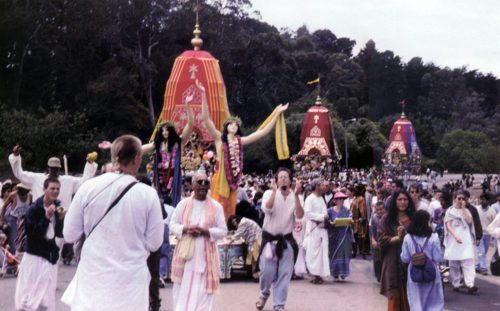
That year, in 1976, Prabhupada took part in the Rathayatra in New York City, when three great chariots, surrounded by thousands of people, moved down what Prabhupada called "the most important street of the most important city." The media reports were most favorable: "East meets West on Fifth Avenue." After that RathayatraSrila Prabhupada wrote to his disciple Jayananda Dasa: "For so long I have wanted to have Rathayatra in New York, and now at long last you have helped me fulfill this long-cherished dream." The Fifth Avenue Rathayatra is now an annual event.
To arrange a Rathayatra always requires the combined endeavors of many dedicated devotees, but this devotee, Jayananda, played an especially important role in arranging the Rathayatras in the West, beginning with San Francisco in 1967. He would build the chariots, buy (or get donated) the food and decorations, make the advertisements and invite people, inspire and organize other devotees, and then chant and dance during the festival while steering the lead chariot.
In 1977 Jayananda, terminally ill with leukemia, organized the spectacular Los Angeles Rathayatra. The festival was a great success, but Jayananda did not take part in it; he left this world a few months earlier. After Jayananda's demise, Srila Prabhupada wrote in a letter, "Jayananda's death is glorious. It is very good that he stated, 'What is the use of such a useless body, better to give it up.' He has left his body very wonderfully and has been transferred to Vaikuntha. . . . I am very proud that I had such a nice disciple. If possible Jayananda's picture should be hung on the ratha of Lord Jagannatha, and in all our temples a day may be set aside for holding a festival in his honor, just as we do on the disappearance days of other great Vaisnavas."
Twelve years later, in 1989, a high school classmate of Jayananda's happened to see ISKCON's Rathayatra festival in Durban, South Africa, and there a devotee showed him a photo of Jayananda on Jagannatha's chariot. Greatly impressed, he wrote to tell his other classmates about the honored status their friend held in the Hare Krsna movement.
Durban is not the only place in Africa where Lord Jagannatha is worshiped. In Kenya, for the last twenty years Rathayatra has been taking place annually in Nairobi (the capital), in Mombasa, and, more recently, in Kisumu. Many thousands of people take part, and the festivals have been praised and supported by successive governments and leaders through the years as being an inspiration and bringing together many tribes and diverse groups.
Around The World
Indeed, Lord Jagannatha's glories have been broadcast around the world, and His devotees can be found everywhere. Srila Prabhupada installed 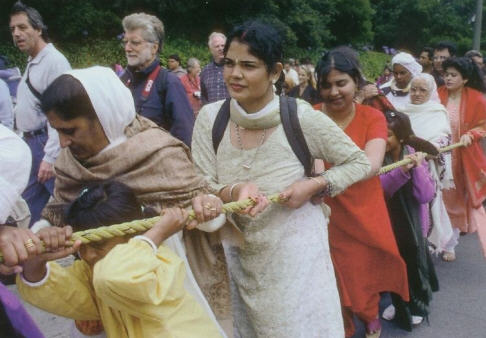 the deities of Jagannatha, Balarama, and Subhadra in Auckland, New Zealand. This year, 2003, the first Rathayatra was held in Mexico. Lord Jagannatha is worshiped in Brazil and other countries of South America. In Brazil, Rathayatra is held in several cities, including Sao Paulo, Rio de Janeiro, Salvador, and Belo Horizonte. A restaurant run by ISKCON devotees in Buenos Aires, Argentina, is called Jagannath Prasadam. In Moscow, Russia, a popular restaurant run by devotees is called Jagannatha Express. The ISKCON temple in Kuala Lumpur, Malaysia, is known as Jagannath Mandir. One of ISKCON's temple communities in Bangladesh is also called Sri Jagannath Mandir, and the place where it is situated is known as Jagannathpur. Both in Bangladesh and in Malaysia the Rathayatra has been held annually since the 1980s, and Muslims together with Hindus happily take part in these transcendental festivals.
the deities of Jagannatha, Balarama, and Subhadra in Auckland, New Zealand. This year, 2003, the first Rathayatra was held in Mexico. Lord Jagannatha is worshiped in Brazil and other countries of South America. In Brazil, Rathayatra is held in several cities, including Sao Paulo, Rio de Janeiro, Salvador, and Belo Horizonte. A restaurant run by ISKCON devotees in Buenos Aires, Argentina, is called Jagannath Prasadam. In Moscow, Russia, a popular restaurant run by devotees is called Jagannatha Express. The ISKCON temple in Kuala Lumpur, Malaysia, is known as Jagannath Mandir. One of ISKCON's temple communities in Bangladesh is also called Sri Jagannath Mandir, and the place where it is situated is known as Jagannathpur. Both in Bangladesh and in Malaysia the Rathayatra has been held annually since the 1980s, and Muslims together with Hindus happily take part in these transcendental festivals.
In Zurich, Switzerland, the presiding Deities are Jagannatha, Balarama and Subhadra, the place is known as New Jagannatha Puri, and Rathayatra is held annually. In Spain, Rathayatra is held in three cities: Madrid, Barcelona, and Malaga. In Italy, the festival is held in Milan. And of course in India Lord Jagannatha's Rathayatra festivals are arranged by ISKCON devotees in many important places, including Delhi, Mathura, Bhubaneswar, Kolkata, Mayapur, Mumbai, Baroda, and Bangalore.
In early 1977, Srila Prabhupada went to Orissa to lay the foundation stone of an ISKCON temple in Bhubaneswar. On several occasions Srila Prabhupada said that because devotees from outside India are not allowed into Lord Jagannatha's temple in Puri, he wanted a beautiful temple built there where anyone, from any country and any community, could come and worship the Lord of the universe.
In November 1977, just a few days before Srila Prabhupada departed this world, his disciple Gour Govinda Swami came from Bhubaneswar to Vrndavana to see him and tell him of various details of the Rathayatra festival, which was special in many ways that year in Puri. Srila Prabhupada listened with great interest and asked many questions. He was especially concerned that the great ancient tradition should be continued purely.
In Former Communist Countries
After the closure of Srila Prabhupada's manifested pastimes, his followers continued to introduce Lord Jagannatha's worship and Rathayatra festivals in new places. With the fall of communist regimes, Rathayatra started in Eastern Europe and different parts of the former USSR. In Budapest, Hungary, Rathayatra is held. In Belarus there are many devotees of Jagannatha. In Riga, Latvia, there are deities of Jagannatha, Balarama, and Subhadra, and They have Their Rathayatra both in Latvia and in Lithuania. There have been Rathayatras in Abkhasia and in Kazakhstan. In Russia, Jagannatha deities are worshiped in Moscow, St. Petersburg, Rostov, Sochi, Seversk, and Tomsk, among other cities.
In St. Petersburg the Rathayatra has taken place every year since 1990. Similarly, in Saratov, on the great Russian river Volga, the devotees have arranged the Rathayatra festival every year since the early 1990s. In the Urals (Ekaterinburg, Perm) and in Siberia (Novokuznetsk, Omsk) Rathayatra is also held annually. In Vladivostok, a major city in the far east, ISKCON devotees have held the Rathayatra festival every year since 1991, and the place is known as New Jagannatha Puri. Even in some smaller places, like Kurjinovo, the Rathayatra is celebrated. In Vladimir, an ancient town not far from Moscow, a small group of devotees has been arranging Rathayatra festivals annually since the mid-1990s. In Dnepropetrovsk, an important city in the Ukraine, their Lordships Jagannatha, Subhadra, and Balarama are worshiped in a beautiful temple and the Rathayatra has been held every year since 1993. ISKCON's center in Dnepropetrovsk is known as New Purushottama Kshetra.
In Europe and America
In North America and the United Kingdom, more cities are joining the "Rathayatra club." Besides San Francisco, New York, London, and other cities mentioned above, the festival is held in Washington, Atlanta, Detroit, Jersey City, Boston, Boise, Buffalo, Vancouver, Birmingham, Leicester, Manchester, Brighton, and other places.
In 1996, the one hundredth anniversary of Srila Prabhupada's appearance in this world, ISKCON organized the first Rathayatra in the history of Scandinavia. It was held in Stockholm, near the palace of the king of Sweden, and devotees from other countries came to take part. Also, in 1996 there was the first Rathayatra in Sofia, Bulgaria, and since then it has been held there annually.
This article contains only an incomplete list of ISKCON centers where Jagannatha deities are worshiped and the Rathayatra is held. Besides the ISKCON temples, hundreds and thousands of devotees all over the world worship Jagannatha in their homes. I'm unable to mention here all the places throughout the world where Lord Jagannatha's Rathayatra is held. The glories of Lord Jagannatha are ever expanded by His pure devotees, and even this tiny presentation could be made only by their mercy.
Akincana-priyabandhu Dasa was born in Moscow, Russia, and met Hare Krsna devotees in 1984. He has been translating Srila Prabhupada's books into Russian since the late 1980s. He lives in Jagannatha Puri, India, with his wife and son and is translating the Tenth Canto of the Srimad-Bhagavatam.
